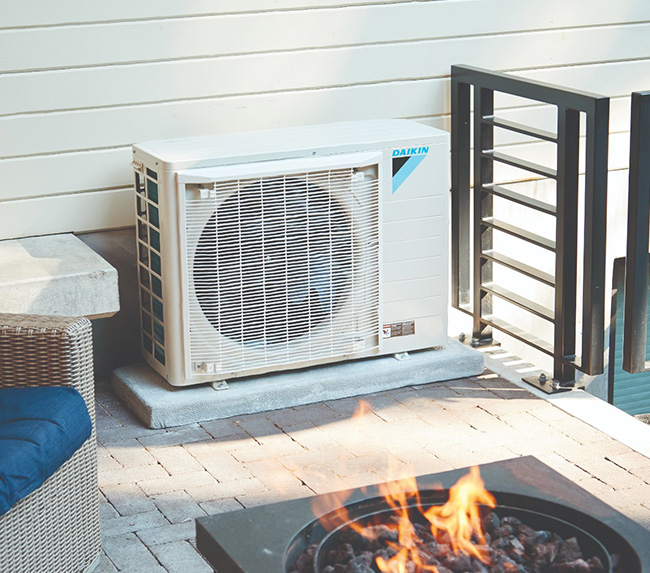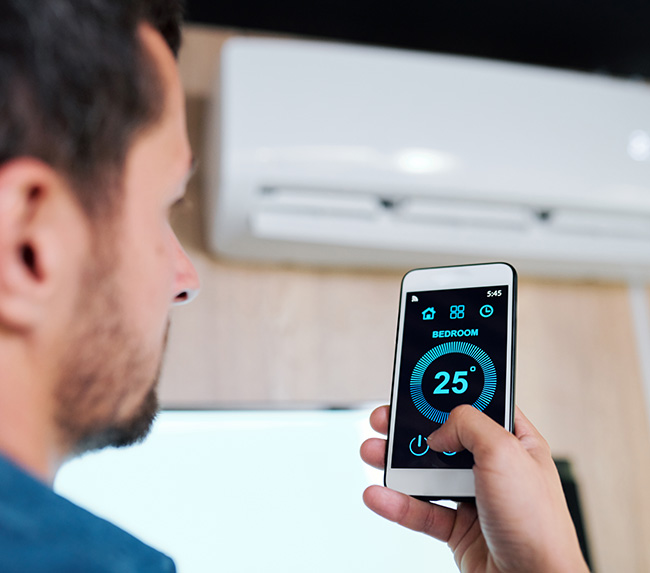In the simplest terms, a heat pump is a unit that transfers heat from one location to another.
An easy way to think about it is that a heat pump works exactly like an air conditioner in the summer. It absorbs heat from the inside of the home and rejects it to the outside; effectively cooling or removing heat from the air inside the home. In the winter months, the heat pump works in reverse absorbing heat from the outside and rejecting it inside.
Part of the confusion when trying to understand a heat pump comes from thinking a heat pump somehow produces cold or hot air. In reality, what it’s doing is just transferring heat from one place to another.
You might be asking yourself what the heck is the “pump” part of this system: A heat pump “pumps” refrigerant through a cycle that effectively changes the pressure and therefore the temperature of the refrigerant. As long as the refrigerant temperature is lower than the air temperature it can still absorb heat. In the same way, as long as the refrigerant is warmer than the air it will reject heat.
The beauty of heat pump technology is that the energy required for this process is not used to create heat but to just move it from one place to another. In this way, the efficiency is very high per unit of energy. At optimal conditions reaching 300% or more.
Almost all heat pumps fundamentally work in the same way. The differences are with regard to the configuration of either ducted or ductless systems. There are many options in this regard which depend on the application and requirements of the home. There are added considerations which we’ll discuss further below.
Main Components of a Heat Pump System
There are two main components to a heat pump system:
Outdoor Unit
This outdoor unit contains a compressor, condenser coil, reversing valve, fan motor, electronic expansion valve, and computer boards. The unit itself looks very similar to a traditional air conditioner. It works to absorb heat from the outside air in winter months. During the summer months, it does the opposite and absorbs heat from the inside and rejects it outside

Indoor Unit
The indoor unit is comprised of an evaporator, blower, and computer boards and is sometimes referred to as an air handler or ductless head. The indoor unit can be either a ductless head or an air handler. The ductless heads are stand-alone units located in each room you want to heat or cool. A fan coil is similar to a traditional furnace system and integrates seamlessly into your heating system.

Types of Heat Pumps
The main types of heat pumps are geothermal (ground-source) and air-source. The simple difference between these two systems is the heat source which in these two cases is the ground or the air.
Geothermal heat pumps transfer heat between your house and the ground. These systems boast lower operating costs but they have higher initial costs to install.
An air-source heat pump is the most common and they transfer heat between the outside air and the home.
Air-Source Heat Pump: Ducted Vs. Ductless Heat Pumps
Air-source heat pumps can be ducted or ductless.
Similar to a standard furnace, a ducted heat pump system uses a centralized air-handling unit that uses a fan to direct the air throughout the ducts in your home.
By comparison, a ductless heat pump system uses smaller wall-mounted units instead to distribute air into the specific rooms they are installed in. And as the name suggests having ducts installed is no longer necessary. These units are often called mini-splits and because they’re ductless they’re great in applications like an extension to a home where it might not make sense to install air ducts.
What are the Benefits of an Air-Source Heat Pump?
ULTRA-EFFICIENT:
Because heat pumps only transfer heat and do not require the need to create heat like other more traditional HVAC systems, they require less energy to operate and are one of the most efficient heating and cooling systems available.
VERSATILE:
Heat pump systems are able to both heat and cool your home. Also, if you decide to install mini-split units you have more flexibility in managing the temperature for each room of your home, including additions.
WHISPER QUIET:
Inverter heat pump technology provides variable-speed fans and compressors. In addition, heat pumps typically have sound jackets on the compressors. Lastly with soft start and stop functions all of these factors contribute to a quiet operation.
ENVIRONMENTALLY FRIENDLY:
Unlike other types of systems, heat pumps run on electricity and do not use fossil fuels making them an environmentally friendly choice.
HEALTHIER AIR:
Many heat pump solutions incorporate air filtration which keeps micro-particles from entering your home.
MINIMAL MAINTENANCE:
Due to the fact there are no combustible components there is less field maintenance as is required with a standard furnace. However, similar to an air conditioner, it’s important to keep the air filters of your heat pump system clean and the outdoor unit clean of dust and leaves.
What Maintenance do Heat Pumps Require?
Heat pumps require minimal maintenance but there are a few things you should do to ensure your system runs optimally for years to come.
- Change the filters regularly
- Clean the outdoor unit regularly and keep snow and debris away
- Get the heat pump inspected annually
Feel free to give us a call to discuss our maintenance program.
Get Started with Marx Mechanical!
Do Heat Pumps Work in Winter?
Yes! Believe it or not, there’s heat in the air even during cold winter months. Even then heat pumps are able to absorb that heat and transfer it into your home. Heat pumps are significantly more efficient than they once were and work well in cold climates. In fact, there are specific heat pumps made for colder climates as we’ll highlight below.
What is a Cold Climate Air-Source Heat Pump?
A cold climate air source heat pump is more efficient and provides heat at lower temperatures compared to conventional heat pump systems. This makes them an ideal choice for colder climates. While supplemental heating is still incorporated, as we outline below, a cold climate air source heat pump is more cost effective and has a lower carbon footprint compared to systems that burn fossil fuels.
Do I Require Supplemental Heating?
Short answer Yes. In cold climates like here in Canada supplemental heating like an electric auxiliary heating element incorporated within the system or electrical baseboards is required. At extremely cold temperatures, the efficiency of a heat pump will begin to drop, and backup heating will be required to maintain your set temperature. Supplemental heating like this is a fail-safe measure to ensure you have heat during all weather conditions. Supplemental heating such as these also can work with your heat pump system during very cold conditions to ensure you get to temperature.
Is a Heat Pump System Right for Me?
In most cases, installing a heat pump system makes a lot of sense. It can help save you money on your monthly bills, provide comfort to your family throughout the year, as well as being an environmentally-friendly choice.
A reputable HVAC company in your area can help you decide the exact system that’s right for you and make sure it’s installed correctly. They can also inform you of potential government rebates, such as Ontario’s Green Homes and Enbridge’s HER+ Programs, and connect you with the right energy advisor.
Overall, heat pumps are increasingly becoming the go-to smart choice to heat and cool homes.
If you’d like to learn more about them and see if they make sense for your home please feel free to contact us.

